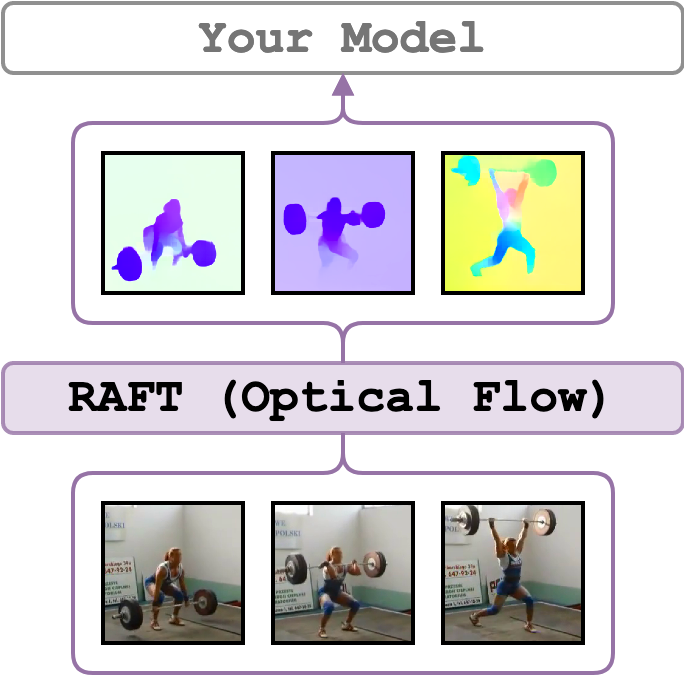RAFT

Recurrent All-Pairs Field Transforms for Optical Flow (RAFT) frames are extracted for every consecutive pair of frames in a video. The implementation follows the official implementation. RAFT is pre-trained on FlyingChairs, fine-tuned on FlyingThings3D, then it is finetuned on Sintel or KITTI-2015 (see the Training Schedule in the Experiments section in the RAFT paper). Also, check out and this issue to learn more about the shared models.
The optical flow frames have the same size as the video input or as specified by the resize arguments. We additionally output timesteps in ms for each feature and fps of the video.
Set up the Environment for RAFT
Setup conda environment. Requirements for RAFT are similar to the torchvision zoo, which uses conda_env.yml
# it will create a new conda environment called 'video_features' on your machine
conda env create -f conda_env.yml
Quick Start
Activate the environment
conda activate video_features
and extract optical flow from ./sample/v_GGSY1Qvo990.mp4 using one GPU and show the flow for each frame
python main.py \
feature_type=raft \
show_pred=true \
video_paths="[./sample/v_GGSY1Qvo990.mp4]"
Note, if show_pred=true, the window with predictions will appear, use any key to show the next frame.
To use show_pred=true, a screen must be attached to the machine or X11 forwarding is enabled.
Supported Arguments
Argument |
Default |
Description |
|---|---|---|
finetuned_on |
sintel |
The RAFT model is pre-trained on FlyingChairs, then it is fine-tuned on FlyingThings3D, and then it is fine-tuned on finetuned_on dataset that can be either sintel or kitti. |
batch_size |
1 |
You may speed up extraction of features by increasing the batch size as much as your GPU permits. |
extraction_fps |
null |
If specified (e.g. as 5), the video will be re-encoded to the extraction_fps fps. Leave unspecified or null to skip re-encoding. |
side_size |
null |
If resized to the smaller edge (resize_to_smaller_edge=true), then min(W, H) = side_size, if to the larger: max(W, H), if null (None) no resize is performed. |
resize_to_smaller_edge |
true |
If false, the larger edge will be used to be resized to side_size. |
device |
"cuda:0" |
The device specification. It follows the PyTorch style. Use "cuda:3" for the 4th GPU on the machine or "cpu" for CPU-only. |
video_paths |
null |
A list of videos for feature extraction. E.g. "[./sample/v_ZNVhz7ctTq0.mp4, ./sample/v_GGSY1Qvo990.mp4]" or just one path "./sample/v_GGSY1Qvo990.mp4". |
file_with_video_paths |
null |
A path to a text file with video paths (one path per line). Hint: given a folder ./dataset with .mp4 files one could use: find ./dataset -name "*mp4" > ./video_paths.txt. |
on_extraction |
print |
If print, the features are printed to the terminal. If save_numpy or save_pickle, the features are saved to either .npy file or .pkl. |
output_path |
"./output" |
A path to a folder for storing the extracted features (if on_extraction is either save_numpy or save_pickle). |
keep_tmp_files |
false |
If true, the reencoded videos will be kept in tmp_path. |
tmp_path |
"./tmp" |
A path to a folder for storing temporal files (e.g. reencoded videos). |
show_pred |
false |
If true, the script will visualize the optical flow for each pair of RGB frames. |
Examples
Start by activating the environment
conda activate video_features
A minimal working example: it will extract RAFT optical flow frames for sample videos.
python main.py \
feature_type=raft \
device="cuda:0" \
video_paths="[./sample/v_ZNVhz7ctTq0.mp4, ./sample/v_GGSY1Qvo990.mp4]"
Note, if your videos are quite long, have large dimensions and fps, watch your RAM as the frames are stored in the memory until they are saved. Please see other examples how can you overcome this problem.
By default, the frames are extracted using the Sintel model.
If you wish you can use KITTI-pretrained model by changing the finetuned_on argument:
python main.py \
feature_type=raft \
device="cuda:0" \
finetuned_on=kitti \
video_paths="[./sample/v_ZNVhz7ctTq0.mp4, ./sample/v_GGSY1Qvo990.mp4]"
If you would like to save the frames, use --on_extraction save_numpy (or save_pickle) – by default,
the frames are saved in ./output/ or where --output_path specifies.
In the case of RAFT, besides frames, it also saves timestamps in ms and the original fps of the video into
the same folder with features.
python main.py \
feature_type=raft \
device="cuda:0" \
on_extraction=save_numpy \
video_paths="[./sample/v_ZNVhz7ctTq0.mp4, ./sample/v_GGSY1Qvo990.mp4]"
Since extracting flow between two frames is cheap we may increase the extraction speed with batching.
Therefore, you can use --batch_size argument (defaults to 1) to do so.
A precaution: make sure to properly test the memory impact of using a specific batch size if you are not sure which kind of videos you have. For instance, you tested the extraction on 16:9 aspect ratio videos but some videos are 16:10 which might give you a mem error. Therefore, I would recommend to tune --batch_size on a square video and using the resize arguments (showed later)
python main.py \
feature_type=raft \
device="cuda:0" \
batch_size=16 \
video_paths="[./sample/v_ZNVhz7ctTq0.mp4, ./sample/v_GGSY1Qvo990.mp4]"
Another way of speeding up the extraction is to resize the input frames.
Use resize_to_smaller_edge=true (default) if you would like --side_size to be min(W, H)
if resize_to_smaller_edge=false the --side_size value will correspond to be max(W, H) .
The latter might be useful when you are not sure which aspect ratio the videos have (the upper bound on size).
python main.py \
feature_type=raft \
device="cuda:0" \
side_size=256 \
resize_to_smaller_edge=false \
video_paths="[./sample/v_ZNVhz7ctTq0.mp4, ./sample/v_GGSY1Qvo990.mp4]"
If the videos have different fps rate, --extraction_fps might be used to specify the target fps of all videos (a video is reencoded and saved to --tmp_path folder and deleted if --keep_tmp_files wasn't used).
python main.py \
feature_type=raft \
device="cuda:0" \
extraction_fps=1 \
video_paths="[./sample/v_ZNVhz7ctTq0.mp4, ./sample/v_GGSY1Qvo990.mp4]"
Credits
- The Official RAFT implementation (esp.
./demo.py). - The RAFT paper: RAFT: Recurrent All Pairs Field Transforms for Optical Flow.
License
The wrapping code is under MIT, but the RAFT implementation complies with BSD 3-Clause.